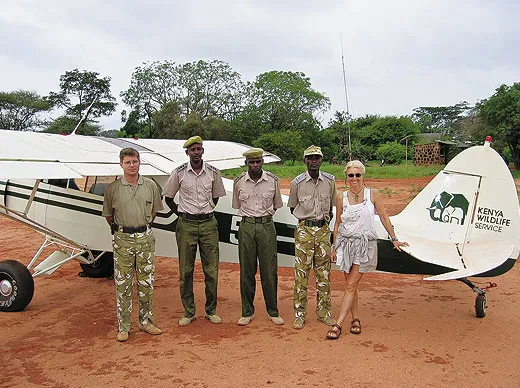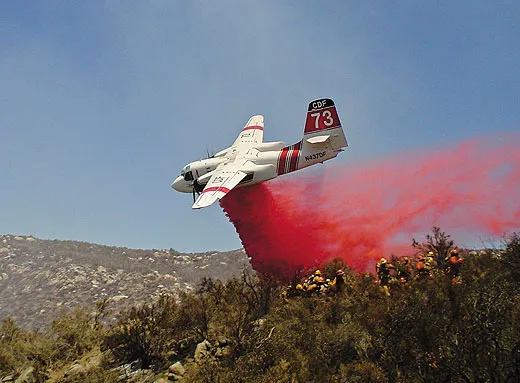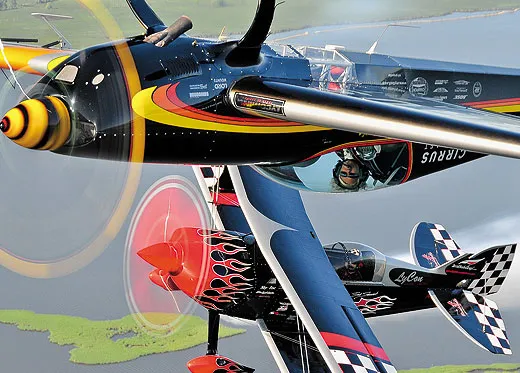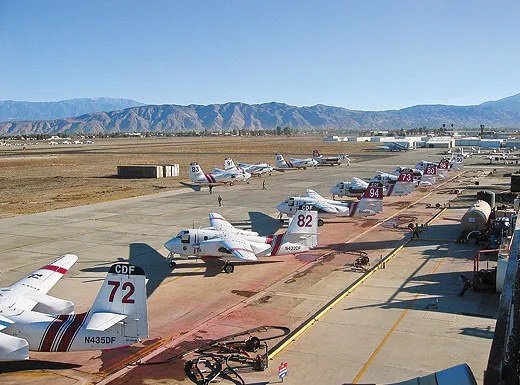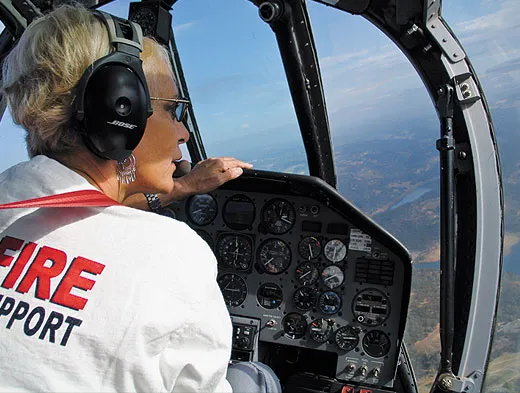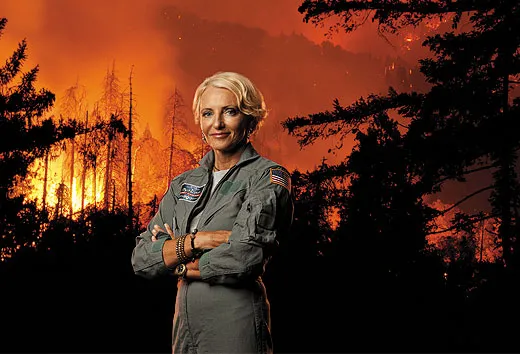Patty Wagstaff’s Second Act
An airshow superstar adds firefighting to her repertoire.
/https://tf-cmsv2-smithsonianmag-media.s3.amazonaws.com/filer/Patty_Wagstaff_4_FLASH.jpg)
When Patty Wagstaff rolls the OV-10A Bronco into a smooth right turn to look at the white smoke below her, she is not above a runway. There are no cheering spectators, no crowd lines, and no ribbon cutting poles. Instead, there are tall trees, rocky hills, and flames. Often, she and her backseater, an air tactical group supervisor, who acts as an air controller, are the first people at a wildfire. Wagstaff will circle well above so her air controller can take in the slope of the hills, the wind that drives the fire, the fuel source, the hazards, and the best path for tankers to swoop down and disperse their retardant chemicals. By the time the tankers, fire engines, bulldozers, helicopters, and ground crews begin to check in on her Bronco’s six radios, her group supervisor will have a plan for them all.
Wagstaff, one of the aerobatic world’s most celebrated champions and a longtime star, still flies airshows, but not during the California fire season. From June through mid-October, she is now part of a team of aerial firefighters with CalFire (the shorthand name for the state’s Department of Forestry and Fire Protection). Like all of CalFire’s new pilots, she began her job in the Bronco. In addition to providing the aerial platform for the air controllers, she is learning to make her way around the world of smoke and fire.
Toward the end of last year’s fire season, I flew out to visit her several times. Now at a base in Santa Rosa, back then she was at the Grass Valley Air Attack base, about 50 miles northeast of Sacramento, which has the feeling of a summer camp. It’s located on an airpark on top of a hill, surrounded by tall trees with a wonderful long view to the west. The rocking chairs on the front porch overlook the base’s three red-and-white airplanes, the Bronco and two Grumman S2T Airtankers. On a quiet late afternoon, they sparkled in the sun like polished sculptures, and it was hard to imagine them as bedraggled workhorses returning from a big fire in need of a scrubbing. But when the quick-call buzzer sounds over the loudspeaker and the crews scramble into their flightsuits, it is thrilling to watch the Bronco dash out like a long-legged horse, followed by the two lumbering, heavily loaded tankers.
I met the people Wagstaff worked with six days a week: the firemen, the dispatchers, the mechanic, the tanker pilots, one U.S. Forest Service pilot, plus the Bronco and tanker relief pilots. They seem to get along like a family, which is partly luck, partly due to the screening process used by DynCorp International, the company that interviews, hires, and manages CalFire pilots. The screeners attempt to pick not only the most qualified fliers but also those with the temperament to endure the extreme rhythms of the job. During the peak of a fire season, the pilots may fly seven hours a day, six days a week, while at the end of the season they could be sitting around the base for days. They read, write, nap, talk, exercise, cook, eat, watch movies, sit on the porch, and hope for a fire call.
Wagstaff and I have been friends and fellow airshow pilots for a long time, and I have seen her at dozens of shows, either performing or poised to perform. In addition to flying, she signs autographs, gives talks, supervises her ground crew, and answers the demands of what seems like ten thousand people. So it was a refreshing contrast to hang out with her at Grass Valley, where she was happy and relaxed among co-workers who liked and admired her, but did not treat her like the aerobatic version of Wonder Woman. In fact, none of the people I met at Grass Valley had ever seen her perform.
"I knew her name and had seen pictures of her in magazines," said tanker relief pilot Charles Lees. "She’s all over the place. But last summer when I was scheduled for a training class, I asked who was in the class with me. They said ‘Patty Wagstaff,’ and I asked, ‘Who is Patty Wagstaff?’ thinking it was a nickname for some pilot who had flown inverted or something.…Then when I met her I expected her to be outgoing, the way she looks in her pictures, but she was very humble.
"Within a day, however, I realized she is also very driven and focused. She doesn’t just assume that she is going to jump in and be able to go do something. She wants to learn from everybody."
Grass Valley Battalion Commander Don Cockrum is one of two air tactical group supervisors who spent a lot of time in Wagstaff’s back seat, and he provided much of her on-the-job training. "I’ve got to hand it to Patty," he said; "she may be a diva in her old profession with many great accomplishments, but here she is the boot camp rookie. All that stuff doesn’t mean anything when you are new to this. But she is a good sport and quick to learn." And there is a lot to learn.
The air attack pilot’s job is to provide a stable platform for the group supervisor: She flies in a way that helps him see what he needs to see, especially the tankers approaching the fire and dropping retardant. Over her radio frequencies, she gets traffic clearances, and she broadcasts to nearby airports to warn other pilots to stay away from the area around the fire. She also listens to her ATGS’s radio conversations.
Cockrum and fire captain Kurt Chamberlain split the work week as Wagstaff’s group supervisors. "It was a steep learning curve for her," Chamberlain says. "We started out by explaining the parts of a fire to her: the flank, the heel, and the head. So pretty soon she understood our strategy of attack. Now she positions me where I can see what I need at all times. Being an ATGS is a multi-tasking job from hell, and she has got to monitor everything I do so she knows where to go and who is calling in on every one of our six radios while I am talking to someone else. After a while I was able to hand off a lot more to her. A lot of pilots just want to fly the airplane, but she’ll check tankers into the fire area for me when I am talking to guys on the ground, if I ask her to." Checking the tankers in means establishing radio contact with them, and giving them the orbit altitude they should reach, the number and altitudes of other airplanes at the scene, ingress and egress procedures to the closest reload base, and hazards in the area. Until they are checked in, the tankers have to stay seven miles from the fire, a strictly enforced rule for preventing mid-air collisions.
Last September, while Grass Valley was quiet, a busted gas main in San Bruno, to the south, had started a raging fire. Wagstaff and tanker pilots Joseph "Hoser" Satrapa and Craig Hunt were looking at photos of it from the night before. One particularly dramatic photo was on television and in the newspapers: an Associated Press shot of Charles Lees dropping a red curtain of retardant into the roiling smoke and flames while flying a CalFire tanker past an airborne fireball.
This fire was a rare monster, and the firefighters talked about it on and off all day: how they had never been in that kind of heat before, how the air was so hot it scorched the paint on the tanker’s fuselage, how a tanker flying through the airborne fireball would have surely crashed. Then over the next few days, the talk turned to past fires. Satrapa recalled that during one, his front window was plastered with retardant slurry from another tanker. Worse, he was at 150 feet. "I climbed straight ahead to a good altitude, slowed to about 95 knots [110 mph], opened the upper hatch, cleared a four-inch space on the windscreen, and headed straight back to Grass Valley," he said.
They talked about how they flew other fires. When they talked about being in the smoke, thinking about a dozen different variables and making split-second decisions, I could see they felt the same heightened awareness that airshow pilots feel low to the ground on a difficult day. I understood how this, too, is Wagstaff’s kind of flying: the quick thinking, the need for exquisitely tuned maneuvering, the adrenaline-producing challenge of managing the risk factors that are always present, just as they are in airshow flying.
She learned to fly in the early 1980s, in Alaska: in extreme weather, near treacherous mountains and icy glaciers. Then she discovered aerobatics, and by 1984 Wagstaff was flying airshows and aerobatic competitions. She became consumed by the pursuit of precision, and rose quickly into the ranks of airshow superstars and world-class aerobatic competitors.
In 1990, then again in 1991 and 1992, she became the first woman to win the overall U.S. National Aerobatic Championship title. After 12 years of winning national and international contests and awards, she stopped competing. In 1994, she donated her Extra 260 to the Smithsonian Institution, which hung it—inverted—in the National Air and Space Museum. She continued performing in an Extra 300S and completed 25 years of full-time airshow flying.
"In 2001, I started thinking about other kinds of flying," she says, "and I had some interesting offers with the airlines, corporate and helicopter test flying. Airshows are pretty tenuous as far as sponsorships.… I realized I needed to think about my future a little bit. It is not like you can’t do airshows forever, because you can, but do you want to do them full-time forever? That’s when I first talked to Hoser and started thinking about fire flying." He told her that she would love the excitement, and the satisfaction of stopping a fire and saving somebody’s life and property.
In 2004 she was inducted into the National Aviation Hall of Fame, got other sponsorships, and volunteered every winter as an instructor to the pilots of Kenya Wildlife Service, an organization devoted to animal conservation. She also spent nine years flying a turbine-powered Raytheon T-6A Texan II as a demonstration pilot, and kept performing in her Extra 300S. But she continued to think about expanding her career into aerial firefighting. Last year, after learning as much as she could about the business, she sent in an application for a slot with CalFire.
She was experienced with turbine engines, mountain and bush flying, and low-level flying, and had an accident-free record, but she had been warned that it would be tough to get hired. In fact, everyone said that the hiring folks would not consider airshow flying a positive. CalFire had one pilot who had flown some West Coast airshows, ex-Marine Bob Finer, but it had never dealt with a full-time airshow pilot before. Jeff Cavarra, DynCorp’s program director for CalFire, was one of the team who interviewed Wagstaff; he says: "We told her, ‘There is zero aerobatics allowed and none of the crazy stuff that you do in the airshow.’ "
Wagstaff replied, "Wait a minute! Aerobatics is the most disciplined form of flying. I don’t do crazy stuff. My flying has to be especially disciplined in an airshow because I do some maneuvers that can hurt me if I am not disciplined."
Cavarra says, "That really impressed me, because we don’t ever deviate unless we have to, but you’ve got to be prepared for the unexpected."
When they called last year and offered her the job, she was ecstatic. "It felt like winning the Nationals [aerobatic championship]," she says.
"When you specialize in airshows, where do you go? When you’re an entertainer or a stunt person, it’s not easy to know where to go next. There isn’t a clear path, so I consider myself so lucky to have found a job that can utilize those same skills, with people of the same kind of temperament and lifestyle."
On her days off she stays near the airport, close enough to hear the fire call, and often she will catch a ride in the right seat of a tanker. She dreams of the day when she has the experience, luck, and seniority to earn a slot among the tanker pilots. "Tanker flying is edgy," she says, "because you are low and in the smoke in places you’ve never been before. Everything is totally different down there: trees sticking up everywhere, small flames and no perspective. When there is a lot of wind, it can be really ugly too, but it’s cool, totally cool! I love it."
Late one afternoon Wagstaff and I sat on the porch at Grass Valley, watching the trees move in the wind and listening to the incoming phone calls over the loudspeaker, while one of the firemen grilled chicken. "Fame is a weird thing," she said. "I needed to get away from it. What is so great here, as you can see, is I just get left alone all day. Nobody expects me to do anything or to be charming. I have never been so relaxed in aviation because I don’t have to be ‘on’ here."
She still loves airshow flying. She finished her 2010 season performing at Naval Air Station Jacksonville in Florida, and last winter her busy 2011 airshow schedule began with a performance in El Salvador.
"Airshows are important," she says. "They are the only PR role that aviation plays anymore, the only place people really get exposed to aviation anymore. You can’t go to a normal airport and just go up and touch someone’s airplane, but you can at an airshow and you can meet the pilots and talk to them. I am really grateful that I have been able to make a living and be part of the airshow business for so long, and to still be a part of it."
She is also grateful to have another exciting flying job that has no retirement age, plenty of compatible fellow pilots, an element of altruism, and a schedule that suits her gypsy lifestyle. At airshows, when people see her in her flightsuit, they thank her for entertaining and inspiring them. Near the fire base, people see her in her CalFire T-shirt and say, "Do you fly one of those red-and-white airplanes? You saved my house."
Frequent contributor Debbie Gary’s last piece for the magazine was “Barnstorming in the Blood” (Aug. 2010).
